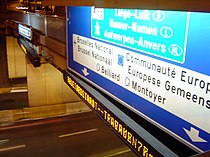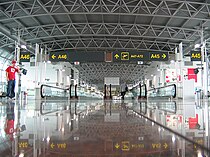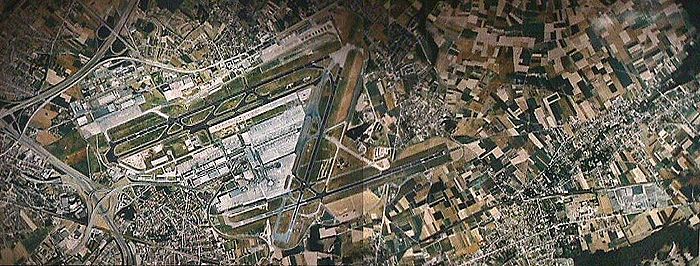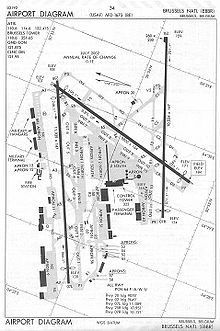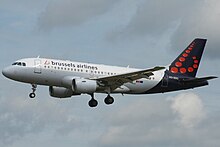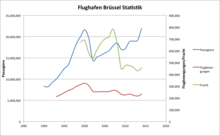Brussels-Zaventem Airport
| Brussels-Zaventem Airport Luchthaven Zaventem |
|
|---|---|
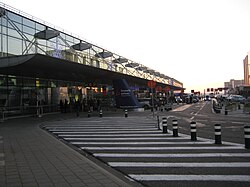
|
|
| Characteristics | |
| ICAO code | EBBR |
| IATA code | BRU |
| Coordinates | |
| Height above MSL | 56 m (184 ft ) |
| Transport links | |
| Distance from the city center | 12 km northeast of Brussels |
| Street | A 201 |
| train | NMBS / SNCB (in planning Thalys / TGV) |
| Local transport | Shuttle buses, taxis |
| Basic data | |
| opening | 1940 |
| operator | Brussels Airport Company SA |
| Passengers | 26,360,003 (2019) |
| Air freight | 500,702 t (2019) |
| Flight movements |
234,460 (2019) |
| Runways | |
| 01/19 | 2987 m × 50 m asphalt |
| 07R / 25L | 3211 m × 45 m asphalt |
| 07L / 25R | 3638 m × 45 m asphalt |
The Brussels-Zaventem Airport (officially Brussels Airport , formerly Dutch Luchthaven Brussel-Nationaal , French Aéroport Bruxelles National ) ( IATA code : BRU , ICAO : EBBR ) is the largest airport in Belgium .
The airport also serves as the military airfield of the Belgian Air Force , who call the airfield the Melsbroek Air Base . They use it as the home base of their transport aircraft.
location
The airport is located twelve kilometers northeast of the Belgian capital, Brussels, in the Flemish municipality of Zaventem and is therefore also called Luchthaven Zaventem or Aéroport de Zaventem . Zaventem is located in the province of Flemish Brabant and borders directly on the Brussels-Capital Region . Due to the language division of Belgium, there were frequent disputes between the French-speaking Belgians (Walloons) and the Dutch-speaking Belgians (Flemings) with regard to night flight regulations. The proposed plans would each put one population group at a disadvantage. The expansion of the airport was often delayed by the ongoing conflicts.
→ See: Flemish-Walloon conflict
To make planespotting easier, the airport has set up two platforms. From them, very good camera perspectives on the runways 01/19 and 25L / 07R are possible.
Transport links
rail
An NMBS / SNCB train station is located in the basement of the airport. From here trains run several times an hour, mainly in the direction of Brussels and over the Nossegem-Spange to Leuven . These trains will be integrated into the RER network in the future . On June 10, 2012, the terminus was converted into a through station by means of the newly built rail tunnel under the runways. Intercity and local trains then continue to run in the direction of Mechelen via the also newly built high-speed line to the north on the central reservation of the A1 motorway . Later, it will also be served by the Thalys high-speed train to Antwerp and beyond.
The proportion of passengers arriving by train is expected to increase from 15 percent in 2005 to 30 percent in the long term.
Street
The airport can be reached by car via the outer ring of Brussels (R0) . It is located at the Zaventem motorway junction in an easterly direction on the A201. The airport is about 15 kilometers by road from the center of Brussels. There are monitored parking spaces and cycle paths for motorcyclists and cyclists. The airport is signposted in two languages, as usual in Brussels as ndl. Brussel Nationaal and French Bruxelles-National or just as Zaventem . Taxi ranks can be found in the tunneled arrival area and the upper check-in area.
Brussels-Zaventem has a large number of bus connections. The airport is connected to the De Lijn , STIB / MIVB , and De Decker-van Riet bus network. Many larger hotels in the city center offer a shuttle service to the airport.
Pedestrians and cyclists
From the municipality of Zaventem , a footpath and cycle path led directly in front of the terminal. There are also monitored bicycle parking spaces on the premises.
tram
The Flemish transport company De Lijn plans to connect the airport towards 2020 as part of the “Mobility Vision 2020” with two tram routes from the new Brabant network from Brussels North Station and Jette.
history

There were initially several airfields around Brussels, including one on the border between Evere and Haeren . This was strategically located, in a large open field and with good train and road connections to Brussels. During the First World War , the German occupation troops built a zeppelin hangar there in 1914 and expanded it further. After the end of the war, the Belgian armed forces took over the airfield, which was conveniently located for the General Staff in the Dailly barracks in Schaerbeek , and reopened it to civil aviation. The Belgian airline Sabena has also been using the airfield since it was founded in 1923, but with increasing use it soon became too small. Today the newly built NATO headquarters is located on the area of the former airfield .
During the Second World War , the German occupation forces then built a new " air base " a few kilometers away with more convenient transport links in Melsbroek . After the liberation of Belgium by the Western Allies, Airfield B.58 , the Allied code name, was used in the final phase and after the end of World War II. a. used by squadrons of the Royal Air Force (RAF).
The military airfield was converted into a commercial airport in 1948, whereby the military use by the 15th Squadron ( 15th Wing ), a transport association of the Belgian Air Force , continues to this day. Due to the constant increase in civil air traffic, the airport in Melsbroek quickly became too small in the 1950s. A new terminal was therefore planned for the expected six million passengers for the 1958 World Exhibition , which took place in Brussels. After the laying of the foundation stone in April 1956 by the then Minister of Transport, Edward Anseele, the new terminal was officially inaugurated on July 5, 1958. The large departure hall typical of the time, designed as the "Sky Hall" by the architects Maxime Brunfaut, Géo Bontinck and Joseph Moutschen, became the symbol of the airport .
Since the terminal was built on the other side of the airport, in the municipality of Zaventem , the airport is now run under this name. The military airport and many cargo areas are further to the north in Melsbroek.
In 1994 a renovated terminal and the associated newly built 650-meter-long Pier B were opened by King Albert II. This is mainly used for non- Schengen and long-haul flights.
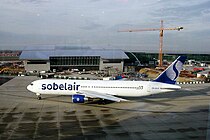
Until its bankruptcy in 2001, the Belgian airline Sabena used the airport as an aviation hub . Its successor, SN Brussels Airlines , merged in 2007 with Virgin Express, which also operates from Brussels, to form Brussels Airlines . In addition, the airport served as the hub of the logistics company DHL until 2008 . From 2007 to 2016, Jet Airways used the airport as a European hub on flights to India, Canada and the USA.
The new Schengen Pier A went into operation in 2002 , replacing older parts of the building, some of which were built in 1958, and the so-called satellite in Pier C. However, this is architecturally protected and is now empty. The new approx. 750 meter long Pier A has glass surfaces all around and therefore offers a good view of the parked aircraft and the parallel Pier B.
In 2005, the new airport tower was completed in the east of the site, in the municipality of Steenokkerzeel . It houses the Belgian air traffic control center, Belgocontrol. In the same year a smoking ban was introduced on the entire airport area.
In 2006 the airport was given its current name Brussels Airport, Welcome to Europe . This is supposed to replace the old name Brussels National (Bruxelles National or Brussels Nationaal) , which however still dominates on most signs and websites (see street sign above). It is thus the only airport in Brussels to distinguish itself from Brussels-Charleroi airport . The airport is also focusing on its international role.
In 2006 and 2007, Brussels-Zaventem Airport was the most punctual airport in Europe.
In 2008, the airport put four new airfield fire-fighting vehicles ( Ziegler Z8 FLF 80 / 125-10 Snozzle) into operation, which can penetrate a burning aircraft with their pointed hoses and extinguish internal fires. Zaventem Airport is the first in Belgium to use this technology.
On March 22, 2016, the terrorist organization “ Islamic State ” (IS) carried out suicide attacks at the airport and in downtown Brussels in the Maalbeek / Maelbeek metro station . According to official figures, 35 people were killed, including three of the attackers, and more than 300 were injured.
Incidents
- On February 15, 1961, a Sabena Boeing 707 crashed on approach. 73 people died, 72 on board (including the entire US national figure skating team) and one on the ground.
- The end of 2000 was an Airbus A319 of Lufthansa assaulted during loading and robbed. None of the passengers who were on their way to the aircraft during the boarding process were injured. The getaway car was found burnt out a little later in a Brussels suburb. A similar incident had previously occurred at Luxembourg Airport .
- In March 2005, a Lufthansa plane was brought under control by 60 exiled Iranians . With the occupation they wanted to demonstrate against the Iranian mullah regime. The police were able to resolve the situation without bloodshed.
- On May 5, 2006, shortly after midnight, a fire broke out in Hangar 40 of Sabena Technics, in which a Belgium Air Force Hercules C-130 and three A320s from Hellas Jet , Armavia and Armenian International Airways burned out completely. The fire could not be brought under control until around 3 a.m.
- On 25 May 2008, a crashed Boeing 747-209F of Kalitta Air , the 76 tons of freight to Bahrain transport should. The machine came off the runway and broke in two. All five crew members were able to get to safety on the evacuation slides , four of whom were slightly injured. The aircraft slid to a collecting hill and stopped just before the HSL-2 - high-speed rail in the direction of lions are.
Terrorist attacks on March 22, 2016
On March 22, 2016 at 8 a.m., two nail bombs were detonated in the public area of the airport. 17 people were killed and around 100 injured in the terrorist attack. Property damage occurred to the infrastructure of the airport. Flight operations were suspended for around 2 weeks; some of the flights were handled via the airports in Liege and Antwerp .
On April 3, 2016, the airport reopened with three Brussels Airlines flights within Europe. Due to operational restrictions and increased safety precautions, some of the flights in Liège and Antwerp were temporarily continued.
Airport facility
The airport building is divided into several floors and has two terminals (piers), both of which can be reached from the central check-in hall on the third floor. The road guidance system leads you to the various areas by car using bridges and tunnels.
The arrivals area, a train station, taxi ranks and bus stops are located on the lower floors. There are also many different parking garages and short-term parking options. There is a Sheraton hotel directly on the premises . The three runways are 2984 m to 3638 m long and enable the take-off and landing of machines such as the Boeing 747. The airport currently handles up to 74 flight movements per hour.
The “Brucargo” freight and logistics center with various hangars, buildings and offices is located in the northwest area of the airport.
The architecture of the entire airport is not uniform as the airport has grown over time and new parts have been added, renovated or left empty. Some parts of the building date from the 1950s. Zaventem thus offers a mix of different architectural epochs.
Departure hall 1
Departure hall 1 is the largest departure hall at Brussels Airport.
All airlines have their ticket sales points and check-in counters here.
The processing rows 1–10 are located here.
Departure hall 1 was built with the entire building until 1994.
Departure hall 2
This extension of departure hall 1 has existed since March 30, 2010.
These two departure halls are connected by two passages.
Departure hall 2 is mainly used by the charter airlines Jetairfly and Thomas Cook Airlines. Check-in counters 11, 12 and 14 are located here. Due to the superstition of various passengers, there is no check-in row 13.
In addition, there is space for two more rows of dispatchers.
Pier A
Pier A is the largest and most modern pier at Brussels Airport.
This pier has 31 “contact gates” which connect the aircraft with passenger boarding bridges.
After 30 months of construction, it was opened on May 15, 2002. This pier is connected to the departure and arrival hall by the connector.
Pier A was originally only designed for Schengen flights, but since October 15, 2008, African and transatlantic flights have also been handled here.
For this purpose, a separate area at the end of the pier was separated, where an additional passport control was set up. Gates A61-A72 were used for these flights. These gates were later named T61 – T72. T stands for transit here.
The main reason for this was to relieve Pier B during the morning rush hour.
Pier A west
Pier A west is a future extension of Pier A to the west.
Pier A west was originally supposed to go into operation in 2016 and be used for non-Schengen flights.
In July 2013, however, it was announced that construction had been stopped for the time being, as passenger growth had declined.
Pier B
Pier B is only used for flights going to non-Schengen countries.
In contrast to Pier A, Pier B consists of two floors. The upper level is used by departing passengers and the lower level is used by arriving passengers. The pier began operating on December 12, 1994.
Pier C
Pier C is located south of the old main building and is no longer used. Pier C is also called a satellite.
In 2008 Brussels Airport announced plans to build a “low-cost” pier in this area. The airport wanted to use this pier to bring more low-cost airlines to Zaventem. Originally this pier was supposed to open in April 2009. After that, a delay to 2010 was announced.
There were also lawsuits because air traffic would increase. On March 17, 2011 it was announced that the low-cost terminal would not be built.
This pier has been renovated to accommodate the airport administration.
Connector
The connector is the newest construction on the airport site.
It is a connecting building between Pier A and the departure and arrival hall. The Connector was officially opened on March 23, 2015 in the presence of the King.
The building has 25 checkpoints, making it the largest airport security area in Europe.
There are various shops in the building. The construction costs were 72 million euros.
Old main building
The old main building was opened for the 1958 World Exhibition and was the main terminal until 1994. It has been expanded several times over the years.
This building is currently being gutted and converted into an office building.
Brucargo
Brucargo is the cargo area of the airport and is located in the Melsbroek and Diegem area. It covers 100 hectares of land. Brucargo opened in 1980.
Traffic figures and international comparison
Airlines & Connections
The airport is served by 76 passenger airlines and 26 cargo airlines , with 206 destinations in 77 countries, mainly in Europe, but also in Africa, Asia and America. Brussels Airlines operates an aviation hub in Brussels-Zaventem, TUI Airlines Belgium is based here.
Connections to German-speaking destinations: Brussels Airlines offers flights to Basel, Berlin-Tegel, Geneva, Hamburg, Hanover, Nuremberg and Vienna, Lufthansa to Frankfurt and Munich and Eurowings to Stuttgart. Austrian Airlines flies to Vienna, Swiss International Air Lines flies to Zurich. Ryanair offers flights to Berlin-Schönefeld, as well as easyJet flights to Basel and Geneva.
Until 2010, DHL operated its own cargo airline based in Brussels under the name European Air Transport (EAT). In March 2008, the European air cargo hub was relocated from Brussels to Leipzig / Halle Airport , as no political consensus was found in Brussels on further expansion and night flight regulations. EAT Leipzig also took over DHL cargo air traffic in April 2010 . The Brussels hub continued to exist as a regional one after 2008.
Jet Airways operated a hub at the airport until 2016 .
List of departing airlines
Adria Airways , Aegean Airlines , Aer Lingus , Aeroflot , Air Algerie , Air Arabia , airBaltic , Air Canada , Air Europa , Air France , Air Malta , Air Moldova , Air Serbia , Air Transat , Alitalia , All Nippon Airways , Austrian Airlines, Blue Air , British Airways , Brussels Airlines, Bulgaria Air , Cathay Pacific , Corendon Airlines , Czech Airlines , Croatia Airlines , Delta Air Lines , easyJet , Egyptair , El Al , Emirates , Ethiopian Airlines , Etihad Airways , Eurowings, Finnair , Fly Egypt , Freebird Airlines , Georgian Airways , Hainan Airlines , HOP! , Iberia , Icelandair , KLM , LOT Polish Airlines , Lufthansa , Middle East Airlines , Pegasus Airlines , Qatar Airways , Qeshm Airlines , Royal Air Maroc , RwandAir , Ryanair , SAS Scandinavian Airlines , SunExpress , Tailwind Airlines , TAP , Tarom , THAI , TUI fly , Tunisair , Turkish Airlines , Ukraine International Airlines , United Airlines , Vueling (as of December 31, 2018).
Passenger volume
In 2000 the airport was still used by around 21.6 million passengers. In 2001, however, the airport suffered badly from the bankruptcy of the Belgian airline Sabena and the effects of the terrorist attacks on September 11, 2001 , so that the number of passengers fell rapidly to around 14.4 million in the following year. In the following years the passenger volume rose continuously, so that in 2014 the pre-crisis level was exceeded for the first time. With almost 23.5 million passengers, a new record volume was reached in 2015. Due to the terrorist attacks , the number of passengers fell in 2016, but reached a new record volume of around 24.8 million passengers in the following year.
| Year of operation | Passenger volume | Air freight | Flight movements |
|---|---|---|---|
| 2019 | 26,360,003 | 500,702 | 234,460 |
| 2018 | 25,675,939 | 543.493 | 235.459 |
| 2017 | 24,783,911 | 535.634 | 237,888 |
| 2016 | 21,818,418 | 494,637 | 223,688 |
| 2015 | 23,460,018 | 489.303 | 239.349 |
| 2014 | 21,933,190 | 453.954 | 231,528 |
| 2013 | 19.133.222 | 429.938 | 216,678 |
| 2012 | 18,971,332 | 459.265 | 223,431 |
| 2011 | 18,786,034 | 475.124 | 233,758 |
| 2010 | 17.180.606 | 476.135 | 225,682 |
| 2009 | 16.999.154 | 449.132 | 231,668 |
| 2008 | 18,515,730 | 661.143 | 258,795 |
| 2007 | 17,876,618 | 783.727 | 264,366 |
| 2006 | 16,707,892 | 719,561 | 254.772 |
| 2005 | 16,179,733 | 702.819 | 253.255 |
| 2004 | 15,634,517 | 664.375 | 252.068 |
| 2003 | 15.194.097 | 607.136 | 252.249 |
| 2002 | 14,410,555 | 536.826 | 256,889 |
| 2001 | 19,684,867 | 583,729 | 305,532 |
| 2000 | 21,637,003 | 687.385 | 325,972 |
| 1999 | 20,048,532 | 674.837 | 312,892 |
| 1998 | 18,400,000 | 595.395 | 300,000 |
| 1997 | 15,900,000 | 531.011 | 277,000 |
| 1996 | 13,400,000 | 464.277 | 264,000 |
| 1995 | 12,500,000 | - | 245,000 |
| 1994 | 11,200,000 | - | 226,000 |
| 1993 | 10,000,000 | - | 211,000 |
| 1992 | 9,200,000 | - | - |
| 1991 | 8,200,000 | - | - |
| 1990 | 8,300,000 | - | - |
| 1989 | 6,900,000 | - | - |
| Continental | |||
|---|---|---|---|
| rank | target | Passengers | Airlines |
| 1 |
|
966.146 | Air Europa, Brussels Airlines, Iberia, Ryanair |
| 2 |
|
927,618 | Brussels Airlines, Ryanair, Vueling Airlines |
| 3 |
|
738.243 | Brussels Airlines, Ryanair, TAP Air Portugal |
| 4th |
|
719.436 | Alitalia, Brussels Airlines, Ryanair |
| 5 |
|
654.712 | British Airways, Brussels Airlines |
| 6th |
|
644.841 | Alitalia, Brussels Airlines, Ryanair |
| 7th |
|
622.816 | Brussels Airlines, Eurowings, Ryanair |
| 8th |
|
591.857 | Brussels Airlines, Easyjet Switzerland |
| 9 |
|
549.296 | Lufthansa |
| 10 |
|
533.863 | Brussels Airlines, Ryanair, TUI Airlines Belgium |
| Intercontinental | |||
| rank | target | Passengers | Airlines |
| 1 |
|
454.187 | Brussels Airlines, Delta Air Lines, United Airlines |
| 2 |
|
295.464 | Brussels Airlines, El Al |
| 3 |
|
231,859 | United Airlines |
| 4th |
|
228.001 | Emirates |
| 5 |
|
197,550 | Air Canada |
| 6th |
|
170,549 | Etihad |
| 7th |
|
169.111 | Qatar Airways |
| 8th |
|
153.025 | Royal Air Maroc |
| 9 |
|
131,388 | United Airlines |
| 10 |
|
130.211 | Hainan Airlines |
Freight volume
The “Brucargo” cargo center to the west of the airport is home to many air freight companies. The air freight volume in Brussels-Zaventem was 7th in a European comparison in 2006, closely followed by Liège Airport (8th). Frankfurt / Main , Amsterdam and Paris CDG airports ranked in the top three of the largest air freight transshipment centers in Europe .
The freight volume in 2007 was 783,727 tons. Due to the relocation of the DHL hub from Brussels to Leipzig, freight volume fell by 15.6% to 661,100 tons in 2008.
Military use
The airport is still used as a military airfield by the Belgian air force as the Melsbroek air base.
The 15th Squadron, a mixed transport formation, is stationed here. Often, due to the proximity to the institutions of NATO and the EU , aircraft from foreign governments also fly into the airport.
Individual evidence
- ↑ brusselsairport.be: Corporate: Our Company ( Memento of March 27, 2015 in the Internet Archive ) (English)
- ↑ a b c d Statistics. BrusselsAirport.be, accessed on March 1, 2020 .
- ↑ Runway 02/20 gets a new name: 01/19. In: brusselsairport.be. August 23, 2013, accessed April 11, 2019 .
- ^ Article of the TAZ about the night flight discussion
- ↑ Spotting Platforms and Accessibility | Brussels Airport. Accessed August 9, 2019 .
- ↑ De luchthaven en het Diabolo-project ( Memento from July 31, 2012 in the web archive archive.today )
- ^ Announcement: Better rail connections to Brussels Airport . In: Eisenbahn-Revue International , Issue 8–9 / 2005, p. 394.
- ↑ brusselsairport.be: Passengers: To & from the airport (English)
- ↑ Brusselsairportexpress ( Memento from April 1, 2009 in the Internet Archive )
- ↑ AirportExpress
- ↑ Mobility vision 2020: What is Brabantnet? De Lijn , accessed on 23 August 2016 (Dutch).
- ↑ above: Brussels Airport fête son 60e anniversaire . Connect - Brussels Airport neighborhood magazine, September 2018 issue, page 7
- ↑ Laurent Vermeersch: Waarom is de luchthaven zo tightly bij de stad gebouwd? Bruzz No. 1581 of August 29, 2017, p. 38
- ↑ Brussels Airport - most punctual airport - 22/02/2008 ( Memento of April 17, 2009 in the Internet Archive ) Press release BIAC on punctuality (archive version)
- ↑ New crash tender for Brussels Airport - 22/04/2008 Brussels Airport fire service puts innovative crash tender into use ( Memento from May 2, 2008 in the Internet Archive ) Press release about the airfield fire engine (archive version)
- ↑ 35 dead - Belgium again increases the number of victims of terrorism . In: Welt Online . March 28, 2016 ( welt.de [accessed April 5, 2016]).
- ^ SPIEGEL ONLINE, Hamburg, Germany: Brussels: Attack on Lufthansa plane . In: SPIEGEL ONLINE . November 1, 2000.
- ^ SPIEGEL ONLINE, Hamburg, Germany: Brussels: Police clear occupied Lufthansa plane . In: SPIEGEL ONLINE . March 11, 2005.
- ↑ Incident report A320 EK-32010 , Aviation Safety Network (English), accessed on February 10, 2020.
- ↑ Incident report C-130H Hercules CH-02 , Aviation Safety Network (English), accessed on February 10, 2020.
- ↑ AFP: US cargo plane crashed in Brussels after take-off ( Memento from May 27, 2008 in the Internet Archive ) On: afp.google.com . May 25, 2008, 8:00 p.m.
- ↑ aerosecure (Simon Widmaier): Boeing 747 breaks in two On: www.aerosecure.de . May 25, 2008, 8:00 p.m.
- ↑ Photos: Boeing 747-209F / SCD Aircraft Pictures - Airliners.net .
- ↑ Airliners.net forum: Kalitta Air B747-200 Crash In BRU .
- ↑ Brussels Airlines website (accessed April 6, 2016)
- ↑ 10 years Pier A op Brussels Airport - flight level. In: Flightlevel. Retrieved April 14, 2016 (nl-NL).
- ↑ Brussels Airport bevriest grote investering. In: HLN. Retrieved April 14, 2016 .
- ↑ Yvan de Beauffort - Terminal Low Cost à Zaventem: EXIT !!! In: www.yvandebeauffort.be. Retrieved April 11, 2019 .
- ↑ Brussels Airport website: Connector. In: www.brusselsairport.be. Retrieved April 11, 2019 .
- ↑ Brussels Airport website: Deloitte kiest voor het "Gateway" built at Brussels Airport. Retrieved April 11, 2019 .
- ↑ BRUtrends. Accessed December 31, 2018 .
- ↑ n-tv news television: The hub comes from Brussels: DHL lands in Leipzig . In: n-tv.de . March 29, 2008.
- ↑ Brussels Airport - Airlines. In: www.brusselsairport.be. Accessed December 31, 2018 .
- ↑ Movements in Brutrends 2017
- ↑ Corporate Info from SAB (English) ( Memento from May 1, 2009 in the Internet Archive )
- ↑ Figures from the BIAC 2007 ( Memento from April 21, 2008 in the Internet Archive )
- ↑ Figures from BIAC 2008. Accessed April 11, 2019 .
Web links
- Airport data on World Aero Data ( 2006 )
- Airport data in the Aviation Safety Network (English)
- Official website of Brussels-Zaventem Airport "Brussels Airport" (Dutch, French, English)
- Information and maps to Brussels Airport

